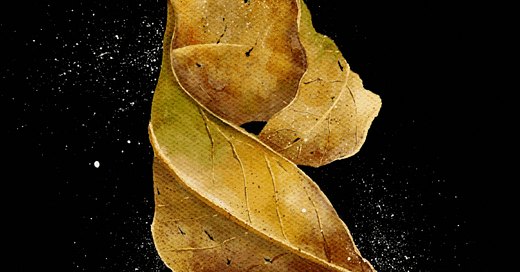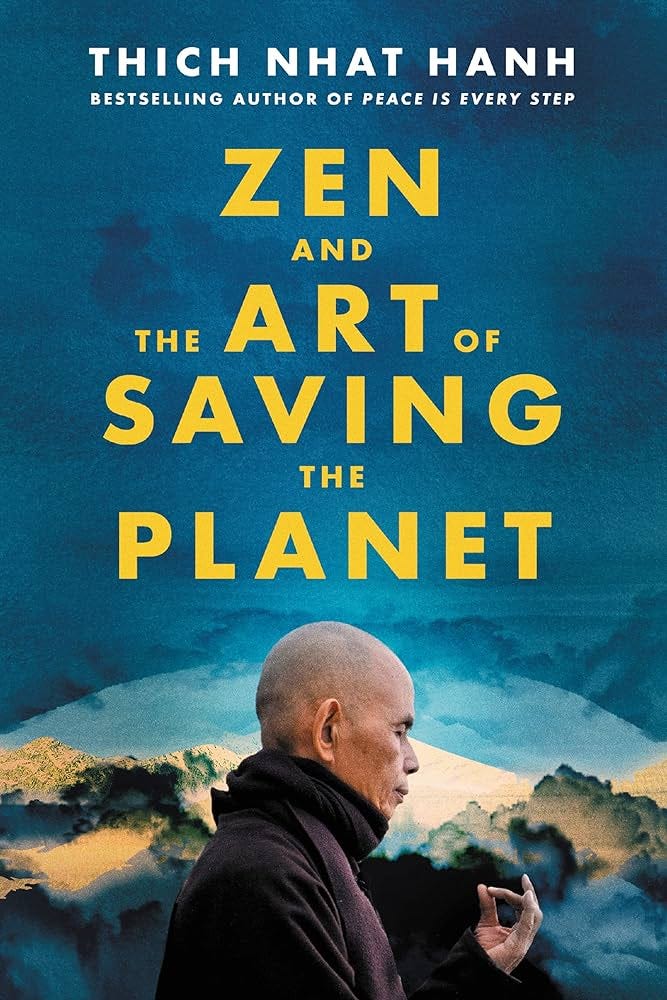Before visiting Plum Village, I read the book and participated in the course ‘Zen and The Art of Saving The Planet’ by Thich Nhat Hanh.
After visiting Plum Village, my course and book notes have come alive.
For your enjoyment, I’ve woven together a tapestry of quotes that resonated, intended for Lectio Sinica — slow meditative reading.
I hope some of these words resonate as deeply with you as it did with me. After all, that’s the nature of interbeing.

Cutting Through Illusion
Zen — The Practice of Looking Deeply
The Sanskrit term for meditation is dhyāna. The Chinese pronounce it chan, in Vietnamese we say thiền, and in Japanese they say zen. The Chinese character 禪 literally means “the practice of reflecting.” In my tradition we use the expression “the practice of looking deeply.”
To meditate doesn’t mean to escape life, but to take time to look deeply. You allow yourself time to sit, to walk—not doing anything, just looking deeply into the situation and into your own mind.

The Way Out is In
We cannot change the world if we’re not able to change our way of thinking, our consciousness. Collective change in our way of thinking and seeing things is crucial. Without it, we cannot expect the world to change.
Decolonize Your Mind — Unbox the World
In Buddhism, the sword of insight is to cut off the view, the label.
With our mind we create the world. Our perceptions are conditioned by language and culture and by society’s tendency to put reality into boxes and categories that simply don’t fit. These discriminating labels limit our clarity and our action to protect the planet and prevent us from living in harmony with each other and with the world.
Mere Recognition
A technical Buddhist term for cultivating simple awareness where we just perceive a sight, sound, thought or feeling without adding any layer of mental commentary on top. We simply “recognize” it.
Embracing The Pain
No Mud, No Lotus
There is a deep connection between suffering and happiness; it’s like the connection between the mud and a lotus flower. When you take time to listen to your suffering and look deeply into its true nature, understanding will arise; when understanding arises, compassion is born. We can call this “the mechanics of compassion.” You make good use of the suffering to create something more positive: compassion. Just like when you use mud to grow lotus flowers, if there’s no mud, there’s no lotus. And, in the same way, if there’s no suffering, there can be no happiness, no compassion.
Learning to Rest
Practice the Practice of Non-Action
A Zen understanding of action, and we learn that how we act—the energy behind our action (non-action)—may be more important than the action itself.
A Moving Silence
An essential condition to hear the call of the Earth and respond to her is silence. If you don’t have silence in yourself, you cannot hear her call: the call of life.
Embodied Mind in a Mindful Body
You are only alive when your mind and body are together. Your mind becomes an embodied mind.
Deep Ecology
The Nature of Interbeing
When you wake up and you see that the Earth is not just the environment, the Earth is us, you touch the nature of interbeing. And at that moment you can have real communication with the Earth.
We are the environment, we are the Earth, and the Earth has the capacity to restore balance.
What’s Your Karmic Footprint?
It is by contemplating interbeing and the energy of our actions (Karma) in the world that we can expand our vision and touch the ultimate truth beyond signs and appearances. By doing so, we can get the realization that every action of body, speech, and mind does have an impact; whatever we do resonates, far wider than we usually imagine. And that gives us a huge motivation to take care of the legacy of our action: whatever we think, say, and do counts.
You are more than you think
When you look deeply into your body, you see that your body is a stream. You can see your parents and ancestors there in that stream. And, in that stream, you can see ancestors and everything—not only human ancestors, but animal, plant, and mineral ancestors. There’s a continuum.
If we allow this conceptual boundary between human and non-human to dissolve, we see ourselves, and the world, in a very different light.
The Path is Made by Walking
Mindfulness Is Not a Tool, It's a Path
Right mindfulness is, first of all, not a tool or an instrument but a path. Right mindfulness is not a means that can be used to arrive at an end.
Widen Your Orbit of Compassion
The practice of mindfulness consists of watering the seed of understanding and compassion every day, so we can restore balance between compassion and violence.
Transforming The Bitter Melon of Suffering
To develop the insights of interbeing, and of transforming the bitter melon of suffering into compassion—we need a regular, solid practice of meditation and mindfulness. We need silence, sitting still, and time in nature, but we also need a framework for being mindful in our way of working, consuming, speaking, listening, loving, and interacting with the world.
Forgetfulness is the Opposite of Mindfulness
Forgetfulness means that you are pulled away by the past, by the future, by your projects, by your anger, by your fear. You’re not truly alive. Every one of us has a seed of forgetfulness and a seed of mindfulness inside, and if we train ourselves a little bit—drinking our tea mindfully, breathing in mindfully, or taking a shower mindfully—after a few days, the seed of mindfulness in us will become stronger.
Engaged Buddhism
Reverence for Life
Engaged Buddhism is a kind of Buddhism that addresses the challenges of the time, in which personal spiritual growth and social service go hand in hand.
when you breathe mindfully or walk mindfully and create joy and peace, that is already a gift for the world. Lighting up the energy of mindfulness in the heart of your family, your community, your city, or your society is engaged action. Compassion and peace radiate from your person.
Non-Violence Is a Path, Not a Tactic
The word for Non-violence in Sanskrit is ahiṃsā. It means not-harming, not causing harm to life, to ourselves, and to others.
The Meditator, the Artist, and the Warrior
The meditator, the artist, and the warrior are not three separate people; they are three aspects of your person. And you should allow all three aspects to be active at the same time in order to have balance. We have to mobilize them all and never let one of them die or become too weak.
Find your Sanga — Supreme spiritual friends
A sangha is a local community of mindfulness practitioners who gather to meditate to share their joys and difficulties, and to encourage each other on the path of practice. Meeting regularly with others to sit and share together is a precious way to cultivate our understanding and compassion and to re-establish our deep connection with others.
Zen and The Art of Coming Back to Life
In systems terms, response to danger is a function of feedback — the information circuit that connects perception to action. Appropriate response depends on an unblocked feedback loop.
If we consider that we are an integral part of our world, then we can see that closing our hearts and minds to its suffering blocks feedback essential to life.
The problem lies not with our pain for the world, but in our repression of it. Our efforts to dodge or dull it surrender us to futility — or in systems terms, we cut the feedback loop and block effective response.
Are you ready to reconnect perception to action and remove the separation between yourself and the earth?
You can now register for the Zen and the Art of Saving the Planet course, which will run from 20th October until 8th December 2024.
It’s a beautiful 7-week in-depth online learning journey to nurture compassion, community, resilience, and mindful action in service of the Earth.
May compassionate (non-)action ripple out into the world from your being.
May you be the feedback loop that regenerates life.














Great summary, Tijn. I also took the ZASP course. Life changing (along with my practice in Plum Village Zen Buddhism).
I like to call this the Triple Ripple Effect. Thanks for sharing.